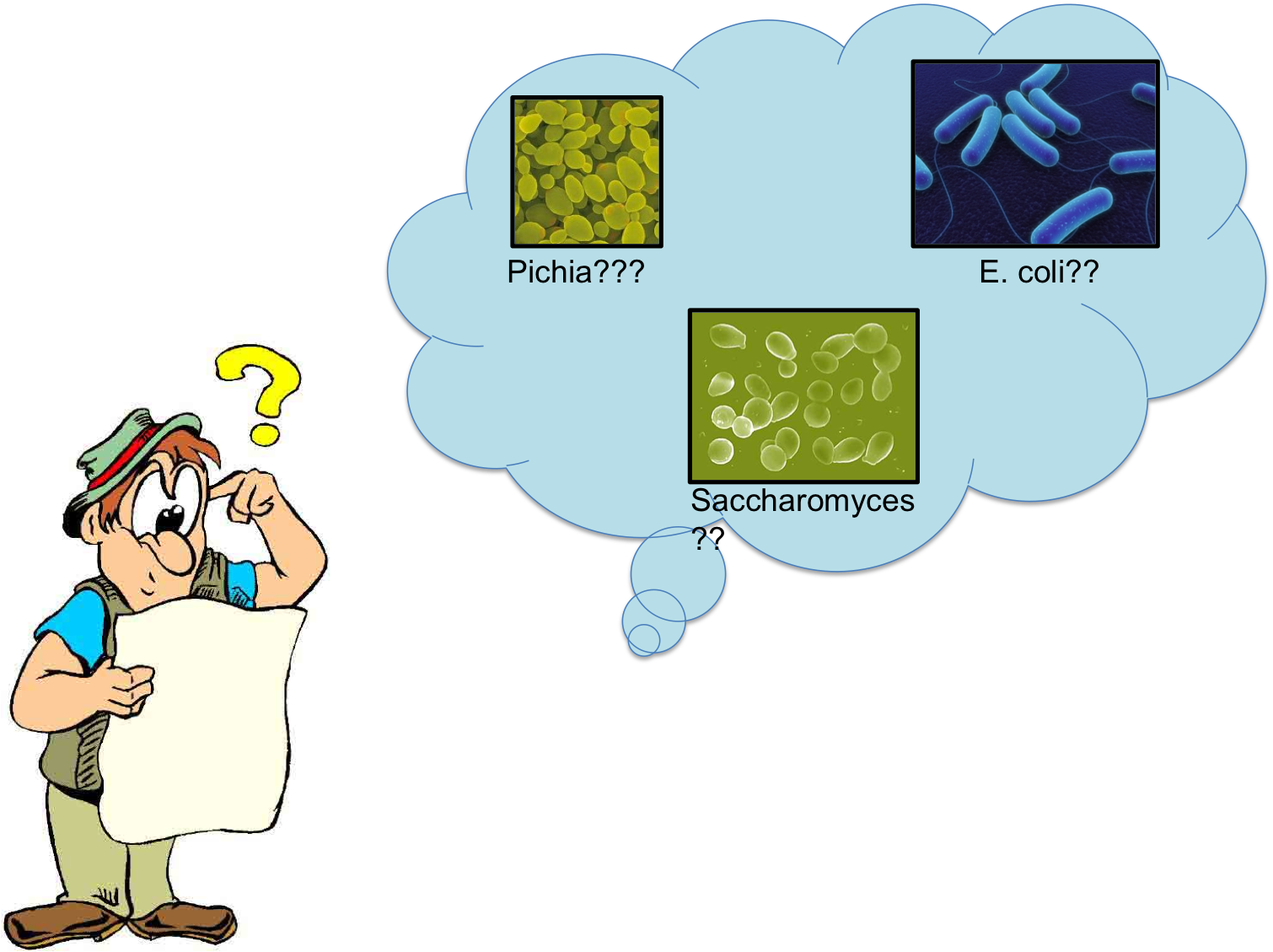Team:Georgia State/WhyPichia
From 2010.igem.org

Contents |
Pichia Vs Saccharomyces
a. Greater Cell Concentrations The preference of Pichia pastoris for respiratory growth is a key characteristic which allows it to be cultured at high cell densities (500 OD600 U ml31)[1]. This trait lends an advantage to Pichia over Saccharomyces cervisiae: Resultant ethanol from S. cervisiae fermentation accumulates which hinders culture growth and therefore protein production. High levels of cell growth in fermenter cultures are vital to foreign protein production since concentration of the secreted product in "extracellular medium is...proportional to the concentration of cells in the culture". [2]
Easy and Inexpensive to Culture
The components of P. pastoris media (glycerol, methanol, salts, trace elements, and biotin) are relatively inexpensive and as such are well suited for large-scale heterologous protein production. The common protocol is to allow P. pastoris to accumulate biomass in a glycerol/carbon-source medium while foreign protein expression is repressed. Once glycerol stocks have been depleted, methanol is added to induce expression. Any undesirable protease activity can be easily averted by adjusting pH. Pichia's broad spectrum of optimal growth pH (3.0-7.0) provides ample wiggle room. A number of other techniques may be employed in minimizing proteolysis including lowering growth rate via methanol-level modulation, addition of protease inhibitors, addition of alternative protease substrates, and even simply lowering process temperature.
High production of foreign Protein while low levels of endogenous protein
Extracellular expression of foreign proteins is favorable to intracellular production due to Pichia's extremely low levels of endogenous protein secretion, which makes it easier to isolate the protein of interest. Pichia vectors can also be cloned with foreign genes which align with a secretion signal (native to the protein, native to Pichia, or native to Saccharomyces), facilitating extracellular production. However, intracellular protein production is also high due to the efficiency--at carefully monitored methanol levels--of the AOX promoter.
[1] Cregg 1999 review paper
[2] Heterologous protein production using the Pichia pastoris expression system (2005). Sue Macaulet-Patric, mariana L. Fazenda, Brian McNeil, and Linda M. Harvey. Yeast (22): 249-270
Pichia pastoris versus Esherichia coli
The bacterium E. coli has been frequently chosen as a host to express recombinant, heterologous proteins. Although many successful experiments have used E. coli as their expression system, P. pastoris has become an increasingly popular alternative due to the shortcomings of E. coli. P. pastoris serves as a better host when attempting to express foreign genes because this yeast can perform post-translational modifications and fold proteins properly, tightly regulate transcription via its wide range of promotors, and be purified easily.
a. Post-translational modifications
Unlike P. pastoris, E. coli cannot perform higher eukaryotic post-translational modifications. As a result, proteins requiring these modifications often fold incorrectly when produced by E. coli. These disadvantages, which result from E. coli’s prokaryotic nature, limit the types of proteins that this system can express. Proteins that contain disulfide bonds or require post-translational modifications such as glycosylation, isomerization, or phosphorylation are not always properly expressed; they can be insoluble or improperly folded, which require additional solubilization and re-folding steps (Daly et al). Take for instance erythropoietin (EPO), a glycosylated protein. When EPO is expressed in E. coli, it is not glycosylated and becomes less resistant to unfolding compared to its natural, glycosylated form (Daly et al). Therefore, additional steps are needed in order to form a stable protein, which is time-consuming, costly, and has the tendency to produce low yields.
A study done by Leuking et al. also supports the use of P. pastoris for protein expression. Vectors were created for both E. coli and P. pastoris using multiple cDNAs from a human fetal brain expression library. Out of the 29 DNA clones, all produced soluble proteins in P. pastoris, while E. coli was much less successful. In E. coli, only nine produced soluble proteins; 15 were detected as inclusion bodies; and five were not expressed at all. These differences are likely due to E. coli’s lack of eukaryotic abilities to perform post-translational modifications and properly fold proteins (Leuking et al).
b. Powerful promoter systems
P. pastoris’s wide range of promotors also aid in its use for foreign protein production. It has many strongly induced promotors, which allow sufficient expression of the genes of interest and therefore, a high concentration of proteins can be easily and inexpensively produced (Weidner et al). The alcohol oxidase genes, AOX1 and AOX2, are frequently used promotors because they are easily induced by methanol; because P. pastoris is methylotropic, meaning it can metabolize methanol as its carbon and energy source, adding methanol to the growth medium will induce these two promotors and then express the desired protein (Macauley-Patrick et al). High concentrations of protein can then be produced. A third advantage that P. pastoris has over E. coli is that proteins expressed by P. pastoris are easily purified (Weidner et al). Because P. pastoris secretes its recombinant protein in the growth medium and secretes low levels of endogeneous proteins, there is a better chance of obtaining high yields of uncontaminated proteins in comparison to E. coli (Weidner et al). In essence, there are fewer steps required to obtain the desired protein.
Works Cited
Daly, Rachel, and Milton T. W. Hearn. "Expression of Heterologous Proteins in Pichia pastoris: a Useful Experimental Tool in Protein Engineering and Production." PubMed.gov. PubMed, 26 Nov. 2004. Web. 25 Oct. 2010. <http://www.ncbi.nlm.nih.gov/pubmed/15565717>.
Leuking, Angelika, Caterina Holz, Christine Gotthold, Hans Lehrach, and Dolores Cahill. “A System for Dual Protein Expression in Pichia pastoris and Escherichia coli.” PubMed.gov. PubMed, 15 Dec. 2003. Web. 25 Oct. 2010. <http://www.ncbi.nlm.nih.gov/pubmed/20186119>.
Macauley-Patrick, Sue, Mariana L. Fazenda, Brian McNeil, and Linda M. "Heterologous Protein Production Using the Pichia pastoris Expression System." PubMed.gov. PubMed, 22 Mar. 2005. Web. 25 Oct. 2010. <http://www.ncbi.nlm.nih.gov/pubmed/15704221>.
Weidner, Maria, Marcus Taupp, and Steven J. Hallam. "Expression of Recombinant Proteins in the Methylotrophic Yeast Pichia pastoris." PubMed.gov. PubMed, 25 Feb. 2010. Web. 25 Oct. 2010. <http://www.ncbi.nlm.nih.gov/pubmed/20186119>.
 "
"
